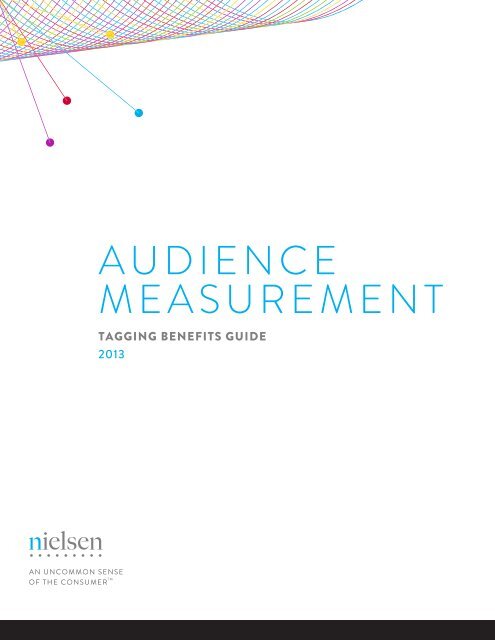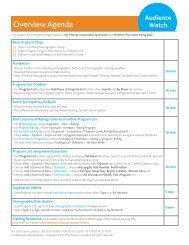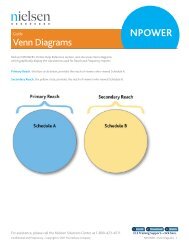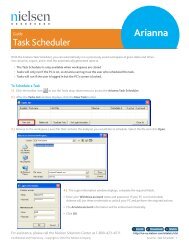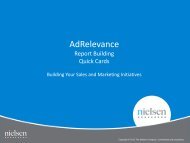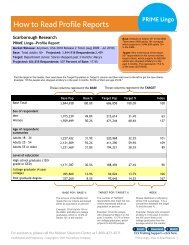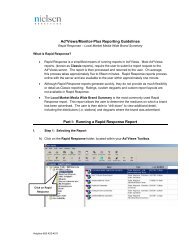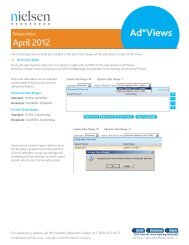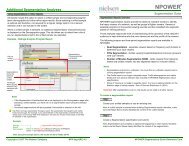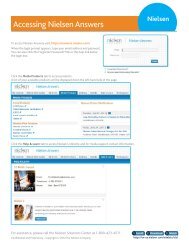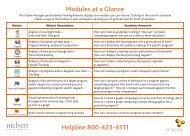Audience Measurement Tagging Benefits Guide - Nielsen
Audience Measurement Tagging Benefits Guide - Nielsen
Audience Measurement Tagging Benefits Guide - Nielsen
Create successful ePaper yourself
Turn your PDF publications into a flip-book with our unique Google optimized e-Paper software.
AUDIENCEMEASUREMENTTAGGING BENEFITS GUIDE2013
AUDIENCE MEASUREMENT: GUIDETAGGING BENEFITSThis document provides the benefitsof implementing <strong>Nielsen</strong>’s audiencemeasurement tag.CONSISTENT MARKETREPORTING<strong>Nielsen</strong> has developed the most advanced tagfor audience measurement, based on years ofexperience, research and development. This tag islight, flexible and effective, allowing a very quickimplementation, using the same normalized tag forall sites. <strong>Nielsen</strong> applies the same and consistentbusiness rules for processing census-based trafficcounting across all publishers in a market. Thislevel of consistency ensures a level playing field foronline publishers and trustworthy, comparable datafor advertisers.CROSS-MEDIA REPORTING<strong>Nielsen</strong> is the only audience data provider uniquelypositioned to help clients understand cross-mediabehavior by their audiences. <strong>Nielsen</strong>’s panel collectsboth TV viewing and PC usage behavior fromthousands of people who have been selected into arepresentative sample. The viewing / usage behavioris then used to inform the <strong>Nielsen</strong> TV Ratingsservice and the <strong>Nielsen</strong> online service. <strong>Nielsen</strong>will be expanding the total number of panelistsmeasured this way in the future and will also addthe measurement of access through Mobile devices.<strong>Nielsen</strong> will provide a complete view of publishers’users regardless of access location or access device.EASY IMPLEMENTATION<strong>Nielsen</strong>’s audience measurement tag is light,flexible and effective, allowing a very quickimplementation. Since the <strong>Nielsen</strong> audiencemeasurement tag is not used for web analyticsreporting, which can have more than 30 differentvariables for customization for clients’ KPIs, itmakes the implementation and instrumentationvery easy. <strong>Nielsen</strong> requires clients to use onlythree simple variables for audience reporting.Most publisher clients are up and running inless than an hour. <strong>Nielsen</strong> provides dedicatedtechnical account managers who ensure thatthe on boarding, instrumentation and ongoingsupport processes are simple and hassle-free.COMPLETE DATACOLLECTIONImplementing <strong>Nielsen</strong>’s audience measurementtag ensures that <strong>Nielsen</strong> is collecting the mostcomplete data from the universe of visitors onyour site. A direct <strong>Nielsen</strong> tag implementationeliminates any data loss that occurs due tothird party redirects or outages within theredirect chain.EFFICIENT DATARECONCILIATIONImplementing <strong>Nielsen</strong>’s audience measurementtag allows for efficient data reconciliationprocesses between <strong>Nielsen</strong> and the clients.<strong>Nielsen</strong> provides localized support with dedicatedtechnical account managers and client servicerepresentatives who work with clients directlyduring data reconciliation processes, thuseliminating the need to go through other thirdparty vendors and data providers.2 VISIT http://en-us.nielsen.com/sitelets/cls/digital-knowledge.html OR CALL 1-800-423-4511
AUDIENCE MEASUREMENT: GUIDEFAQ3 5WILL MY SITE(S) BEREPORTED IN NIELSEN’SHYBRID SYSTEM IF IDON’T TAG?<strong>Nielsen</strong>’s does its best to report on the most accuratemetrics for all of our publishers. <strong>Nielsen</strong> will initially(during the BETA period) report on entities thatare tagged separately from the current NetViewreporting system. Once the hybrid solution goeslive, <strong>Nielsen</strong> will report both tagged and non-taggedentities within its standard audience reporting.Tagged and untagged sites will be clearly marked as“Tagged”, “Partially Tagged”, or “Not Tagged”. It’slikely that advertisers will have an additional level ofconfidence in the accuracy of the numbers that aredisplayed as “Tagged”.4WHAT WILL IT COST TOBE TAGGED WITHINNIELSEN’S SERVICE?<strong>Nielsen</strong> does not charge separately for tagging.The publishers tagging with <strong>Nielsen</strong>’s audiencemeasurement tag is included in your existing servicecontract. An addendum is required to be added toyour contract.WILL IMPLEMENTINGTHE NIELSEN TAG IMPACTTHE USER EXPERIENCEON MY WEBSITE?As the <strong>Nielsen</strong> tag is inserted at the very bottomof the page just before the close body tag,this ensures that all of the website content isdownloaded before the <strong>Nielsen</strong> tag is executedand it will not interfere with the user’s experience.The <strong>Nielsen</strong> tag is a small block of JavaScript codethat does not require any additional elementsfrom an external JavaScript file.6CAN THE NIELSEN TAGIDENTIFY SINGLE PAGEVISITORS?Yes, the <strong>Nielsen</strong> tag is able to identify single pagevisitors. In the past, pre version 5.2 codes, therewas no distinction made between a “first timevisitor” and a “cookie blocker”.• A first time visitor is some browser that hasnever visited a site tagged by SiteCensus(i.e. they do not have a tracking cookie),or a visitor who has visited the site but hassince deleted their tracking cookie.• A cookie blocker is some browser that isblocking the SiteCensus tracking cookie,they will never acquire a cookie based on theprivacy settings of their browser or softwareinstalled on their computer.4 VISIT http://en-us.nielsen.com/sitelets/cls/digital-knowledge.html OR CALL 1-800-423-4511
AUDIENCE MEASUREMENT: GUIDEFor these pre 5.2 versions of the collection code,when the collection server receives a request from abrowser without a cookie, the system assumes thatthe browser is blocking cookies and writes a recordwith an empty (NULL) cookie value. A response issent back to the browser with a newly created cookievalue. If the browser is a first time visitor, the cookiewill be stored by the browser and will be transmittedon the second and subsequent requests.This strategy works well for sites that have a highfrequency or high average pages per browser.However, there are some sites that do receive asignificant fraction of their traffic from first timevisitors (sometimes referred to as “single pageturners”). The types of sites that fall into thiscategory are those that might receive a large amountof traffic referred via search engines or that receivea lot of affiliate referral traffic.The <strong>Nielsen</strong> backend implements a scaling algorithmto account for non-cookied data; however, thisscaling becomes less accurate as the number of noncookiedrecords increases. The scaling algorithmalso assumes that each browser generates, onaverage, the same number of page impressions. Ifthe first time visitors represent a large fraction ofnon-cookied records then the scaling algorithm mayover/under project the number of unique browsers.The solution to this problem is to perform a checkto distinguish between a cookie blocker and a firsttime visitor.• When the collection server receives a requestfrom a browser without a cookie it firstchecks whether “first visitor check” is enabled(controlled via the check_cookie parameter).• If the check_cookie parameter is not set, thenthe record is written, a new cookie is generatedand set in the response back to the browser.This is the pre v5.2 code behavior.• If the check_cookie parameter is set thenthe data node generates a new cookie andsends a 302 redirect back to the browser.The redirect URL has the flag “ja=1”(just assigned) appended to it.• When the browser receives the 302 redirectwith the cookie it makes a second request tothe collection server. The URL of the requestis identical to the first request, with theaddition of the “ja=1” flag at the end ofthe URL.• When the data node receives this secondrequest, it checks for a cookie value. If thereis no cookie the data node can assume thatthe browser is a cookie blocker and writesa record with a NULL cookie id. If there isa cookie on the request, the data node canassume that this was a first time visitor whoaccepted the tracking cookie, it then writesthe cookie into the record.It is important that the first visitor cookie checkbe implemented with caution in a few cases:• An existing client with significant historicaldata and a noticeable fraction of theirtraffic (> 5%) made up of non-cookie data.Technical support will need to be enlistedto determine this fraction. Enabling the firstvisitor check for the clients may significantlychange their unique browser number.The first visitor check should be implementedin all other cases.Copyright © 2013 The <strong>Nielsen</strong> Company5
AUDIENCE MEASUREMENT: GUIDEFAQ7HOW OFTEN DOESNIELSEN UPDATE THE LISTOF BOTS AND SPIDERSFROM THE IAB??There are a number of things <strong>Nielsen</strong> does toeliminate traffic generated by spiders, web-crawlersand other automated robots -ABCe AND IABNote that, once a month, the ABCe (Audit Bureauof Circulations) in the UK and the IAB (InteractiveAdvertising Bureau) in the USA publish identicallists of robot User Agents and IP addresses to beexcluded. These are the lists we use as the basisof our exclusion lists.1.) Exclude traffic based on User Agent.All ‘well behaved’ web-crawlers, for example: thosefrom search engines, are readily identifiable fromthe User Agent. The basis of the exclusion list weuse is an industry standard list from ABCe and IABplus some others that we have identified as beingrobots/web-crawlers.2.) Exclude traffic based on IP address.Traffic is excluded from IP addresses know togenerate robot traffic. Again, the basis for the listwe use is from ABCe and IAB. We have also addedsome other IP addresses that we have identified asbeing from robots.3.) Exclude ‘non-human’ behavior.We also analyze traffic to detect and eliminatepatterns of page impressions that could notreasonably have come from a human user. We countthe number of records are received from a particularsource within each second, hour and day. If thereare too many to have been generated by a liveuser, then traffic from that source is eliminated forthe day.The exact formula for excluding traffic based onbehavior is not made public; otherwise click fraudrobots could be deliberately designed to operatejust under the set limits.6 VISIT http://en-us.nielsen.com/sitelets/cls/digital-knowledge.html OR CALL 1-800-423-4511


